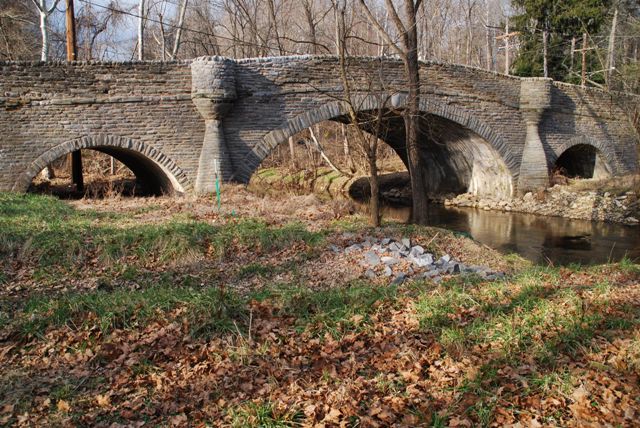We Recommend:
Bach Steel - Experts at historic truss bridge restoration.
BridgeHunter.com Phase 1 is released to the public! - Visit Now
Goshen Road Bridge

Primary Photographer(s): Elaine Deutsch
Bridge Documented: January 7, 2012
Rural: Delaware County, Pennsylvania: United States
Not Available or Not Applicable
45.0 Feet (13.7 Meters)
84.0 Feet (25.6 Meters)
21.7 Feet (6.61 Meters)
3 Main Span(s)
23103400603474

View Information About HSR Ratings
Bridge Documentation
View Archived National Bridge Inventory Report - Has Additional Details and Evaluation
View The National Register of Historic Places Nomination For This Historic Bridge
This stone arch bridge was designed to look like an ancient European stone arch bridge. It contains an elaborate design that includes an ornate plaque and a fancy keystone with the date inscribed into it. The bridge includes small "pedestrian refuges" which is where the parapet bows out at the piers to provide people a place to step out of the roadway and away from traffic. These pedestrian refuges were common on ancient stone arch bridges in Europe, but were apparently never common in the United States. Finally, the bridge's three spans include a large center span flanked by a much smaller span at each end. The varying span sizes add to the distinctive appearance of the bridge. Despite its design made to simulate ancient stone arch bridges, the bridge is not extremely old in the context of American stone arch bridges, with a 1905 construction date. The bridge was clearly designed to be something very special; an architect was a part of the bridge's design. Most of the stone arch bridges in this region were simply designed by local engineers and builders without the input from an architect.
Information and Findings From Pennsylvania's Historic Bridge InventoryDiscussion of Bridge The 3-span, 84'-long stone arch bridge was surveyed as part of the 1982 historic bridge survey and is listed in the National Register. The bridge was built in 1905 by J. A. Morris and designed by noted architect Theophilus P. Chandler. The rusticated stone arch bridge consists of one longer center span flanked by two shorter spans. The buttressed centerspan piers are capped by circular-plan pedestrian refuges. An approximately 30'-long section of stone parapet at the northwest wingwall has been lost and replaced by a horizontally scored concrete parapet. The pedestrian refuge at the center span's southwest corner has been removed (ca. 1990) Discussion of Surrounding Area The bridge carries a 2 lane road over a stream in a sparsely developed, forested setting. Bridge Considered Historic By Survey: Yes |
![]()
Photo Galleries and Videos: Goshen Road Bridge
Bridge Photo-Documentation
Original / Full Size PhotosA collection of overview and detail photos. This gallery offers photos in the highest available resolution and file size in a touch-friendly popup viewer.
Alternatively, Browse Without Using Viewer
![]()
Bridge Photo-Documentation
Mobile Optimized PhotosA collection of overview and detail photos. This gallery features data-friendly, fast-loading photos in a touch-friendly popup viewer.
Alternatively, Browse Without Using Viewer
![]()
Maps and Links: Goshen Road Bridge
Coordinates (Latitude, Longitude):
Search For Additional Bridge Listings:
Bridgehunter.com: View listed bridges within 0.5 miles (0.8 kilometers) of this bridge.
Bridgehunter.com: View listed bridges within 10 miles (16 kilometers) of this bridge.
Additional Maps:
Google Streetview (If Available)
GeoHack (Additional Links and Coordinates)
Apple Maps (Via DuckDuckGo Search)
Apple Maps (Apple devices only)
Android: Open Location In Your Map or GPS App
Flickr Gallery (Find Nearby Photos)
Wikimedia Commons (Find Nearby Photos)
Directions Via Sygic For Android
Directions Via Sygic For iOS and Android Dolphin Browser
USGS National Map (United States Only)
Historical USGS Topo Maps (United States Only)
Historic Aerials (United States Only)
CalTopo Maps (United States Only)

